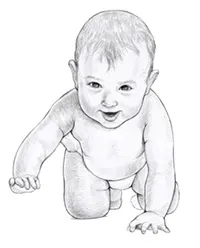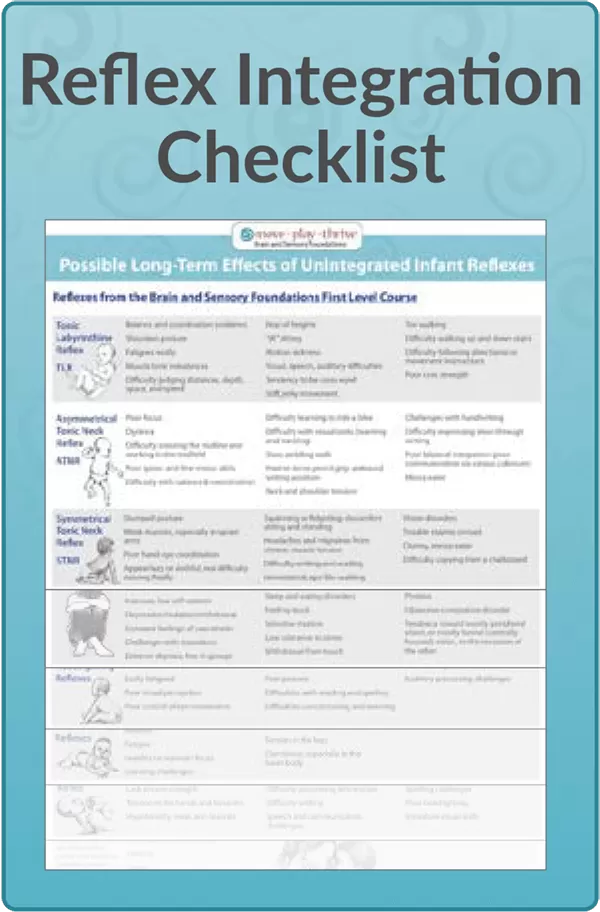Crawling Reflexes
 There are enormous benefits to crawling, and healthy infants whose movements are not restricted will naturally engage in various forms of crawling. The crawling reflexes and crawling itself are immensely important for optimal physical, sensory, emotional, and cognitive development. Infants are meant to engage in both belly crawling and hands-and-knees-crawling. Smooth, aligned crawling builds muscle tone, coordination, and helps to develop sensory systems.
There are enormous benefits to crawling, and healthy infants whose movements are not restricted will naturally engage in various forms of crawling. The crawling reflexes and crawling itself are immensely important for optimal physical, sensory, emotional, and cognitive development. Infants are meant to engage in both belly crawling and hands-and-knees-crawling. Smooth, aligned crawling builds muscle tone, coordination, and helps to develop sensory systems.
Crawling reflexes begin to emerge in the womb and are primarily stimulated when pressure is applied to a prone infant’s foot. This pressure can come from contact with the ground or the mother’s body.
Remarkably, newborn infants are capable of crawling to the mother’s breast to initiate feeding. Known as The Breast Crawl, this action is driven by a series of instinctive behaviors and primitive reflexes. It lays the groundwork for successful self-latching and breastfeeding, and creates a wonderful first opportunity for bonding between mother and child. When a healthy, un-medicated newborn is placed on the mother’s abdomen immediately after birth—ideally with skin-to-skin contact—and then left undisturbed, it allows the newborn to engage in The Breast Crawl. The newborn will reflexively push her feet and move her arms against the mother’s body, propelling herself up to the breast and latching without assistance. This digging in of the feet also aids the mother in dispelling the placenta. Numerous reflexes are engaged during various phases of The Breast Crawl including: Hand reflexes, Feet reflexes, and the Facial-Oral reflexes necessary for breastfeeding.
- The Bauer Crawling reflex emerges around 28 weeks in utero, and should be active until the third month of life. It initially aids in the birthing process and in The Breast Crawl, and later reemerges to facilitate the acquisition of crawling on the belly and hands-and-knees crawling.
- The Automatic Gait reflex—also known as the Stepping Reflex—emerges around 37 weeks in utero. It becomes dormant at approximately 6 weeks of age, and is meant to reappear between 8 and 12 months when the infant is learning to crawl and then walk. It works with the Bauer Crawling reflex to develop crawling, and may also play a part in The Breast Crawl.
Crawling is dependent on the action of many primitive reflexes in order to develop optimally. Crawling eventually helps to further mature the primitive reflexes; particularly the Hand and Feet reflexes along with STNR. It also supports the development of the vestibular and proprioceptive senses, and is vital for binocular vision and balanced hearing. Crawling provides sensory stimulation, matures the brain, and enhances cognitive functioning, most likely via growth and myelination of neural networks.
If an infant skips the crawling stage, engages in it only briefly, or uses compensatory movements instead of coordinated cross-lateral movements, then a variety of challenges can occur.
Possible Long-Term Effects of Retained Crawling Reflexes, Insufficient or Improper Crawling include:
- Motor delays
- Poor spatial awareness
- Vestibular underdevelopment/poor balance
- Lack of coordination
- Low muscle tone
- Poor posture
- Gait irregularities
- Restricted, effortful movement due to a lack of flexibility in the legs
- Ocular-motor issues
- Dyslexia
- ADHD
- Learning deficits
- Slow mental processing due to poor myelination
- Speech delays
When crawling is compromised or missing, it is imperative to intervene as early as possible. See this article for therapists' perspectives on crawling, recommendations, and research on the benefits of crawling.
For optimal development, all walkers, jumpers, or other devices that restrict movement and prevent an infant from crawling—usually by prematurely putting them into a standing position—should be avoided.
- Amphibian Reflex
- Asymmetrical Tonic Neck Reflex
- Birth and Bonding
- Crawling Reflexes
- Crossed Extensor Reflex
- Facial-Oral Reflexes
- Fear Paralysis Reflex
- Feet Reflexes—Plantar & Babkinski
- Foot Tendon Guard
- Hand Reflexes—Grasp, Palmar, and Babkin
- Headrighting Reflexes
- Infant Torticollis
- Landau Reflex
- Moro Reflex
- Parachute Reflex
- Pull-to-Sit Reflex
- Spinal Galant Reflex
- Spinal Perez Reflex
- Symmetrical Tonic Neck Reflex
- Tonic Labyrinthine Reflex
Sources
Henderson, A. (2011). Understanding the breast crawl: Implications for nursing practice. Nursing for Women's Health, 15(4), 296-307.


